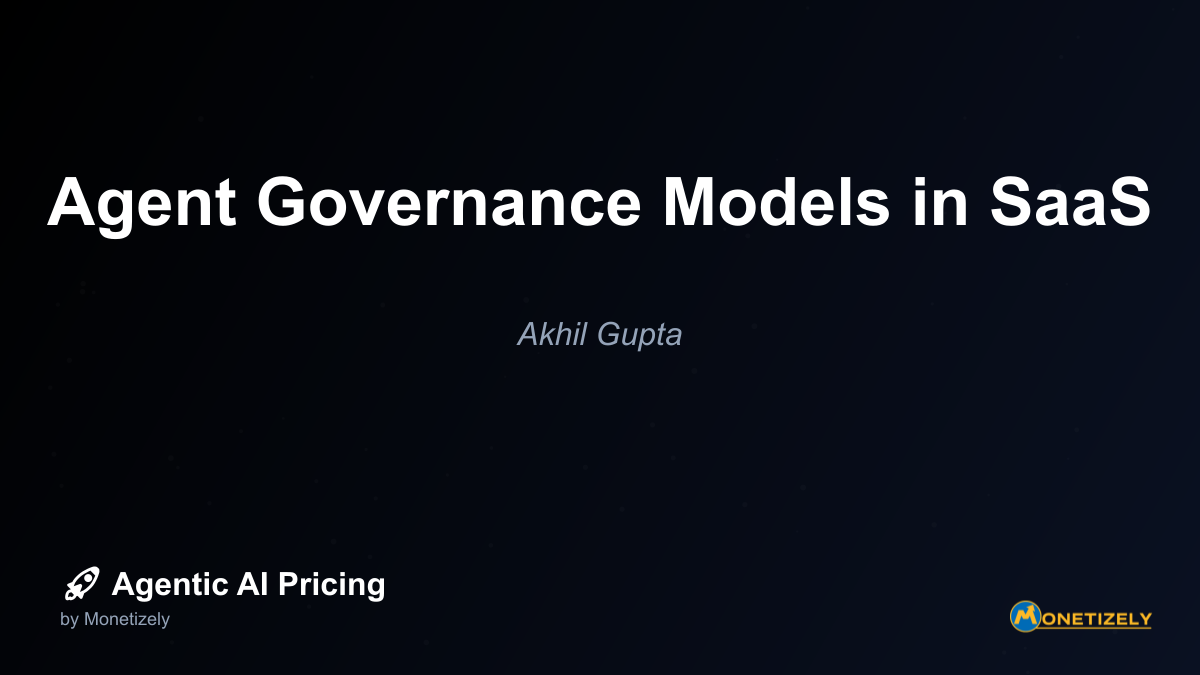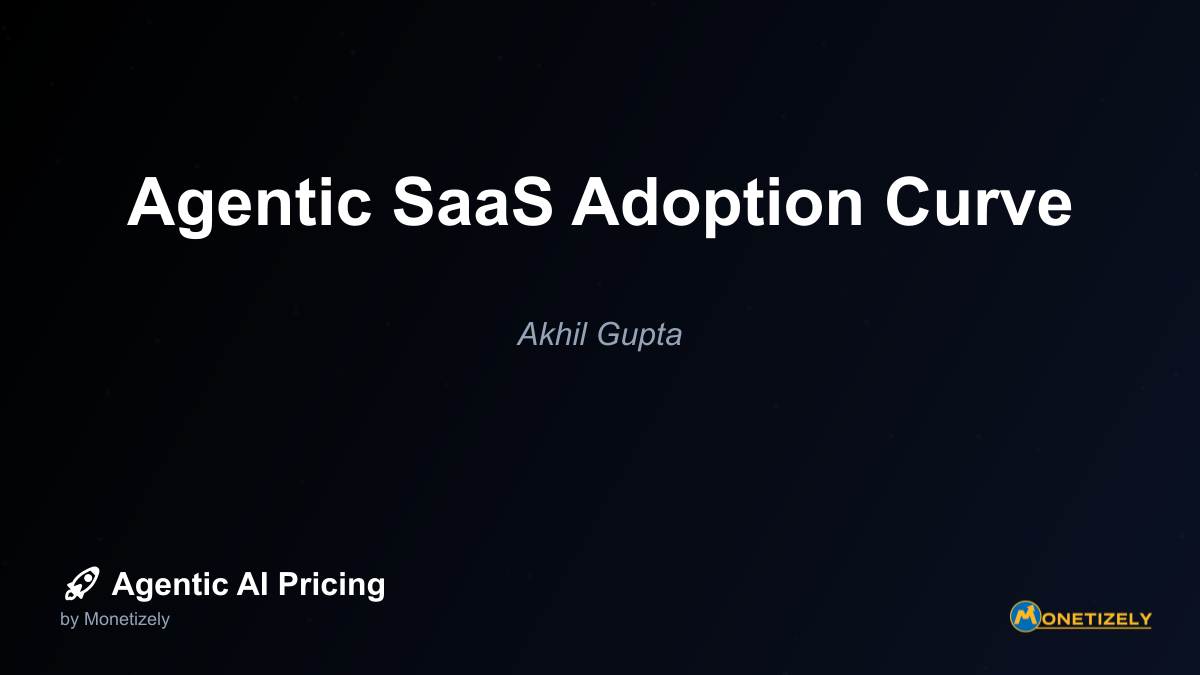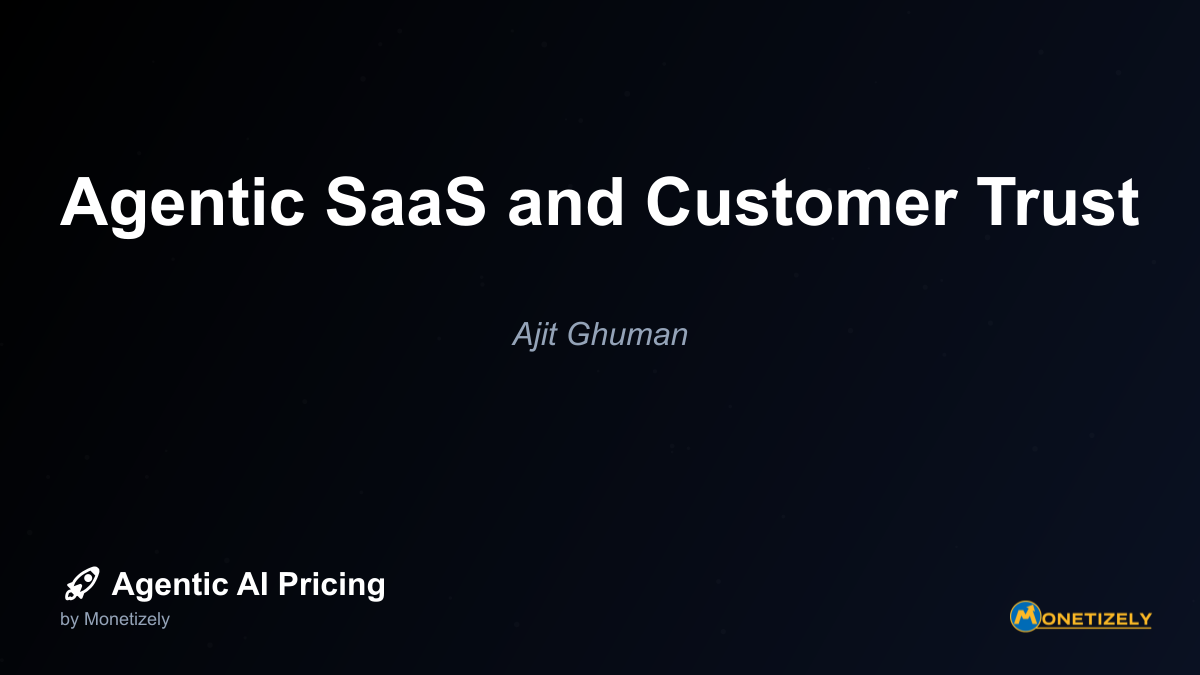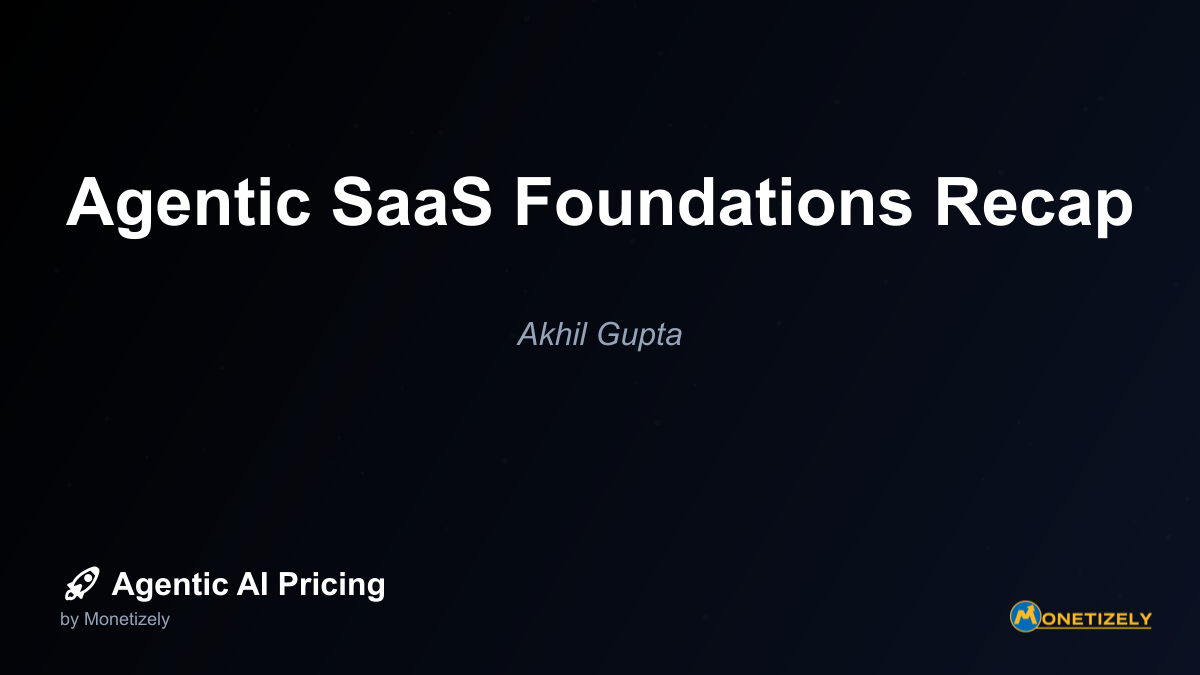· Ajit Ghuman · Agentic SaaS Fundamentals · 12 min read
Why Autonomy Matters in SaaS
AI and SaaS Pricing Masterclass
Learn the art of strategic pricing directly from industry experts. Our comprehensive course provides frameworks and methodologies for optimizing your pricing strategy in the evolving AI landscape. Earn a professional certification that can be imported directly to your LinkedIn profile.

In the rapidly evolving landscape of software as a service (SaaS), one characteristic has emerged as the defining factor that separates truly transformative solutions from incremental improvements: autonomy. While automation has long been a staple feature of software systems, autonomy represents a fundamental shift in how we conceptualize, design, and deliver value through SaaS platforms.
The Autonomy Imperative: Beyond Simple Automation
The distinction between automation and autonomy is crucial for understanding the future of SaaS. Automation follows predefined rules and workflows, operating within narrow constraints to execute repetitive tasks. In contrast, autonomy embodies a system’s capacity to operate independently, make decisions, adapt to changing circumstances, and pursue goals with minimal human intervention.
This shift from rule-based automation to true autonomy represents the natural evolution of software systems:
- Rule-Based Automation: Early SaaS relied on static, manually-coded rules (if-this-then-that)
- Machine Learning-Based Automation: Systems that learn from data patterns, improving decisions beyond fixed rules
- True Autonomy: LLM-powered agentic AI that can reason, self-improve, and operate at scale with minimal human supervision
As Ajay Agarwal, partner at Bain Capital Ventures, noted in a recent industry conference: “The most valuable SaaS companies of the next decade won’t just automate tasks—they’ll autonomously drive outcomes. This represents a fundamental shift in how software delivers value.”
Defining Autonomy in SaaS
Autonomy in SaaS systems can be measured across several dimensions:
Degree of Decision-Making Authority
Autonomous systems possess varying levels of authority to make and execute decisions without human approval. This spectrum ranges from systems that merely suggest actions (requiring human confirmation) to those that can independently initiate and complete complex workflows.
Self-Governance Features
Truly autonomous SaaS exhibits self-governance through capabilities like:
- Self-monitoring: Continuously evaluating its own performance
- Self-healing: Identifying and resolving issues without human intervention
- Self-optimization: Improving operations based on feedback and outcomes
Adaptability to Changing Environments
Unlike rigid automation, autonomous systems can adapt to new situations, unexpected inputs, and changing business requirements without requiring reprogramming or manual adjustments.
Proactive vs. Reactive Behavior
Automation is inherently reactive—responding to triggers or events. Autonomy enables proactive behavior, where systems anticipate needs, identify opportunities, and initiate actions to achieve goals.
The Technical Architecture of Autonomous SaaS
Building truly autonomous SaaS requires a sophisticated technical architecture with several key components:
Control Plane and Application Plane Separation
Modern autonomous SaaS architectures separate the control plane (provider-managed) from the application plane (which may run in the tenant’s environment). This architectural pattern, popularized by AWS and other cloud providers, enables autonomous management of core functionalities while respecting tenant isolation and security requirements.
Multi-Tenant or Mixed-Tenant Models
Autonomy is facilitated by architectures that balance shared components for scalability with dedicated components for tenant-specific autonomy in areas like customization, data security, and performance tuning.
Microservices and Serverless Integration
Autonomous SaaS leverages microservices to modularize functionality, enabling fine-grained autonomous operation of services. These microservices often run in containers or serverless environments optimized for specific functions (e.g., batch jobs vs. real-time processing).
AI/ML Component Integration
The integration of AI/ML components is essential for true autonomy. These components enable:
- Natural language understanding and generation
- Decision-making under uncertainty
- Pattern recognition and anomaly detection
- Continuous learning and adaptation
Scalability and Adaptivity Infrastructure
Architectures must prioritize scalability to adapt autonomously to varying loads with auto-scaling, load balancing, and failover mechanisms built-in.
Agency vs. Autonomy: Understanding the Distinction
While the terms “agency” and “autonomy” are sometimes used interchangeably in discussions about AI systems, they represent distinct concepts that are both essential to understanding the future of SaaS.
Agency refers to the capacity of a system to act intentionally and make decisions based on goals, plans, and environmental inputs. It involves goal-directed behavior that often entails interaction with an environment to achieve objectives.
Autonomy is a broader concept, meaning the system can operate independently without human control or intervention over a period of time. Autonomous systems self-regulate, adapt, and make decisions unaided.
In short, agency emphasizes purposeful action and decision-making capability, whereas autonomy highlights independence in operation and self-management. An AI agent has agency; an autonomous AI system combines agency with self-governance and minimal external supervision.
The most powerful SaaS solutions combine both qualities—they act with purpose (agency) while operating independently (autonomy).
The Business Value of Autonomous SaaS
The shift toward autonomous SaaS isn’t merely a technological evolution—it fundamentally transforms the business value proposition of software services.
Enhanced Operational Efficiency
Autonomous SaaS dramatically reduces the need for human intervention in routine operations, enabling organizations to:
- Scale operations without proportional increases in headcount
- Redirect human resources to higher-value strategic activities
- Operate 24/7 without staffing constraints
- Reduce operational errors and inconsistencies
Improved Customer Experience
Autonomy enables SaaS platforms to deliver superior customer experiences through:
- Proactive service delivery that anticipates customer needs
- Personalized interactions adapted to individual preferences
- Faster response times and issue resolution
- Continuous improvement based on usage patterns and feedback
According to a 2024 McKinsey study, companies implementing autonomous SaaS solutions reported a 30-50% improvement in first-response times and significantly higher customer satisfaction scores compared to traditional systems.
Accelerated Innovation
Autonomous systems can:
- Continuously test and optimize features without manual oversight
- Identify patterns and insights that humans might miss
- Adapt to emerging trends and user behaviors in real-time
- Enable rapid experimentation with minimal risk
Competitive Differentiation
As basic automation becomes table stakes, autonomy emerges as a key differentiator in crowded SaaS markets:
- Creating unique value propositions beyond traditional SaaS
- Enabling new business models and revenue streams
- Establishing higher barriers to entry for competitors
- Building stronger network effects through autonomous learning
How Leading Companies Approach Autonomy
Major technology companies are taking varied approaches to embedding autonomy in their SaaS offerings:
Microsoft
Microsoft integrates autonomous AI agents into its SaaS ecosystem via Microsoft 365 Copilot and Azure Cognitive Services. Their approach blends large language models with domain-specific applications to automate user tasks and workflows across their productivity suite.
Microsoft’s CEO Satya Nadella has positioned AI-driven autonomy as central to the company’s future, stating that “AI will fundamentally change every software category, starting with the largest category of all – productivity.”
Google embeds language models and autonomous agents into Google Workspace and their Cloud AI Platform. Their approach emphasizes data privacy and multi-tenant scalability with the Google Cloud foundation.
Google’s Duet AI for Workspace represents their vision of autonomous assistance that can draft emails, summarize documents, generate presentations, and create spreadsheet formulas with minimal user input.
OpenAI
While not traditionally a SaaS provider, OpenAI’s influence on autonomous SaaS is profound. They focus on providing foundational LLM APIs that SaaS developers can integrate as autonomous agents for workflows, combined with fine-tuning and reinforcement learning to enable autonomy.
Anthropic
Anthropic prioritizes agentic AI systems built on safe, interpretable LLMs designed to support autonomy with robust alignment features. Their Claude assistant is increasingly being integrated into SaaS platforms to provide autonomous capabilities with an emphasis on safety and transparency.
The Relationship Between LLMs and Autonomous Agents
Large Language Models (LLMs) have become the cognitive engine powering many autonomous SaaS systems. However, an LLM alone does not create autonomy—it must be integrated into a broader agent architecture.
LLMs as the Cognitive Foundation
LLMs provide several capabilities essential for autonomy:
- Natural language understanding and generation
- Reasoning about complex problems
- Knowledge retrieval and synthesis
- Contextual awareness and memory
From LLMs to Autonomous Agents
Transforming an LLM into an autonomous agent requires additional components:
- Planning and goal-setting mechanisms: Enabling the agent to break down complex tasks
- Tool use capabilities: Allowing the agent to interact with APIs, databases, and other systems
- Memory systems: Both short-term context and long-term knowledge retention
- Self-evaluation: The ability to assess performance and adjust behavior
- Feedback incorporation: Learning from successes, failures, and human input
As Sebastian Thrun, founder of Udacity and former Google VP, observed: “An LLM is like a brain without hands. To create true autonomy, we need to give these systems the ability to act in the world, observe outcomes, and improve over time.”
Measuring the Effectiveness of Autonomous Features
As organizations invest in autonomous SaaS, they need robust metrics to measure effectiveness and ROI.
Key Performance Indicators
Standard metrics for measuring autonomous SaaS effectiveness include:
- Task Completion Rate: Percentage of tasks or workflows completed without human input
- Autonomy Level Index: Degree of human intervention needed, from fully manual to fully autonomous
- Response Time and Latency: Speed of autonomous decision-making
- Accuracy and Precision: Correctness of autonomous actions and predictions
- User Satisfaction and Engagement: Feedback reflecting improved experience due to autonomy
- System Uptime and Reliability: Autonomous systems must maintain high availability without human fixes
ROI Measurement Framework
Companies are measuring the ROI of autonomous features through various approaches:
- Increased user retention and engagement due to improved UX from autonomous support
- Expansion revenue from usage-based charges triggered by autonomous task scaling
- Reduction in customer support costs via autonomous troubleshooting
- Direct business outcomes like increased productivity, revenue, or cost savings
According to a 2025 SaaS Pricing Benchmark Study, companies with advanced autonomous features command 30-40% higher average contract values compared to competitors with basic automation.
Impact on SaaS Pricing and Monetization
The rise of autonomous SaaS is transforming pricing models and monetization strategies across the industry.
Evolution of Pricing Models
Traditional SaaS pricing models are being reimagined to capture the value of autonomy:
- Usage-based pricing is increasingly favored, with 56% of SaaS companies incorporating consumption elements by 2025, particularly in data-intensive or AI-driven SaaS
- Outcome-based pricing ties costs directly to the business results autonomous features generate
- Hybrid models combine subscriptions with usage-based fees to balance predictable revenue with value-based scaling
- Tiered autonomy allows customers to pay for increasing levels of system independence
Value-Based Pricing Opportunities
Autonomous capabilities create new opportunities for value-based pricing:
- Time savings: Charging based on human time saved through autonomous operation
- Risk reduction: Pricing tied to decreased error rates or compliance violations
- Business outcomes: Fees linked to specific business metrics improved by the autonomous system
- Decision quality: Monetizing the improved accuracy of autonomous decision-making
Pricing Transparency Challenges
The complexity of autonomous systems creates challenges for pricing transparency:
- Customers may struggle to predict costs when autonomous systems make usage decisions
- The “black box” nature of some AI systems makes value attribution difficult
- Organizations must balance complexity with understandable pricing structures
Implementation Challenges and Best Practices
While the potential of autonomous SaaS is enormous, implementation comes with significant challenges.
Common Implementation Hurdles
Organizations frequently encounter these obstacles when adding autonomous features:
- Technical Complexity: Embedding AI components that operate autonomously requires robust architecture, real-time data processing, and integration with existing SaaS infrastructure
- Data Quality and Availability: Autonomous systems depend heavily on high-quality, timely data streams
- User Trust and Control: Balancing autonomy with user oversight to prevent unwanted actions
- Scalability and Performance: Autonomous features often demand heavy computation
- Regulatory Compliance: Autonomous decision-making may trigger regulatory scrutiny
- Cost and ROI Uncertainty: Developing autonomous functions involves high upfront investment
Best Practices for Success
Leading organizations have developed effective approaches to overcome these challenges:
- Start with bounded autonomy: Begin with well-defined, limited domains where autonomous operation has clear value and manageable risk
- Implement strong observability: Ensure comprehensive monitoring and logging of autonomous system behavior
- Design for human collaboration: Create effective interfaces for humans to guide, override, and learn from autonomous systems
- Establish clear governance: Define policies for when and how autonomous systems can make decisions
- Build in continuous learning: Design systems that improve based on outcomes and feedback
- Focus on explainability: Ensure autonomous decisions can be understood and explained to users and stakeholders
The Relationship with Digital Twins and Simulation
Autonomous SaaS increasingly leverages two powerful complementary technologies: digital twins and simulation-based learning.
Digital Twins as Enablers of Autonomy
Digital twins—virtual replicas of physical systems—provide autonomous SaaS with critical capabilities:
- Real-time monitoring and state representation
- Predictive modeling of future states and outcomes
- Safe testing environments for autonomous decision-making
- Continuous calibration based on real-world feedback
Industries like manufacturing, logistics, and healthcare are combining digital twins with autonomous SaaS to enable predictive maintenance, supply chain optimization, and personalized treatment planning.
Simulation-Based Learning
Simulation environments allow autonomous systems to learn and improve through virtual experience:
- Training autonomous agents in safe, controlled environments
- Accelerating learning by simulating years of experience in days
- Testing autonomous decisions in rare or dangerous scenarios
- Evaluating multiple strategies before deploying in production
As Demis Hassabis, CEO of DeepMind, noted, “Simulation is the bridge between the digital and physical worlds. It allows autonomous systems to learn from experience without the constraints and risks of the real world.”
Security Implications of Autonomous SaaS
As SaaS systems become more autonomous, security considerations evolve in complexity and importance.
Expanded Attack Surface
Autonomous SaaS increases attack surfaces as AI components self-configure and make decisions without human checks. This creates new vectors for exploitation:
- Adversarial attacks that manipulate input data to cause erroneous autonomous actions
- Data poisoning attacks targeting the learning mechanisms of autonomous systems
- Supply chain vulnerabilities in the AI components and models
Security Best Practices
Organizations implementing autonomous SaaS should consider:
- Implementing robust authentication and authorization for autonomous actions
- Establishing clear boundaries and constraints on autonomous decision authority
- Creating comprehensive audit trails of autonomous system behavior
- Developing incident response plans specific to autonomous system failures
- Conducting regular security assessments that include AI-specific vulnerabilities
Regulatory Considerations
The regulatory landscape for autonomous systems is rapidly evolving:
- The EU AI Act establishes risk categories and compliance requirements for autonomous systems
- Industry-specific regulations in healthcare, finance, and other sectors impose additional requirements
- Organizations must implement governance frameworks that ensure compliance while enabling innovation
Industries Leading Autonomous SaaS Adoption
While autonomy offers benefits across sectors, certain industries are seeing particularly rapid adoption and value creation.
Data-Intensive Sectors
Cloud data platforms and analytics companies are leveraging autonomous features to optimize data processing, storage, and analysis. Companies like Snowflake and Databricks are embedding autonomous capabilities that adjust resource allocation, query optimization, and data management without human intervention.
Manufacturing and IoT
The combination of IoT sensors, digital twins, and autonomous SaaS is transforming manufacturing operations. Autonomous systems monitor equipment health, predict maintenance needs, optimize production schedules, and adapt to changing conditions in real-time.
Marketing and Sales
AI-driven autonomous SaaS is revolutionizing customer engagement through:
- Autonomous campaign optimization and budget allocation
- Personalized content generation and delivery
- Predictive lead scoring and qualification
- Conversational commerce and support
Financial Services
Financial institutions are deploying autonomous systems for:
- Fraud detection and prevention
- Algorithmic trading and portfolio management
- Credit risk assessment
- Regulatory compliance monitoring
Healthcare
In healthcare, autonomous SaaS is improving patient outcomes through:
- Medical image analysis and diagnostic support
- Patient monitoring and early intervention
- Treatment planning and optimization
- Clinical workflow automation
The Future of Autonomy in SaaS
As we look toward the future, several trends will shape the evolution of autonomous SaaS.
Increasing Levels of Autonomy
Current systems typically operate with limited autonomy in specific domains. Future systems will feature:
- Broader decision-making authority across multiple domains
- Longer periods of independent operation without human oversight
- More complex goal-setting and strategic planning capabilities
- Greater adaptability to novel situations and requirements
Multi-Agent Systems
The next frontier involves multiple autonomous agents collaborating to solve complex problems:
- Specialized agents with different capabilities working together
- Emergent problem-solving through agent interaction
- Market-based mechanisms for resource allocation between agents
- Human-agent teams with fluid collaboration patterns
Ethical and Responsible Autonomy
As systems become more autonomous, ethical considerations become paramount:
- Transparent decision-making processes that can be audited and explained
- Value alignment to ensure autonomous systems act in accordance with human values
- Fairness and bias mitigation in autonomous operations
- Appropriate levels of human oversight and intervention capability
Regulatory Evolution
The regulatory landscape will continue
Co-Founder & CEO
Ajit is the author of Price To Scale, a top book on SaaS Pricing and is the Founder of Monetizely. Ajit has led and worked in pricing and product marketing at firms like Twilio, Narvar and Medallia. His work has been featured in Forbes and VentureBeat. Ajit regularly consults with software companies from Seed stage to post-IPO on pricing strategy. Ajit is also a highly-rated co-instructor for 'The Art of SaaS Pricing and Monetization' on Maven.
Pricing Strategy Audit
Let our experts analyze your current pricing strategy and identify opportunities for improvement. Our data-driven assessment will help you unlock untapped revenue potential and optimize your AI pricing approach.




